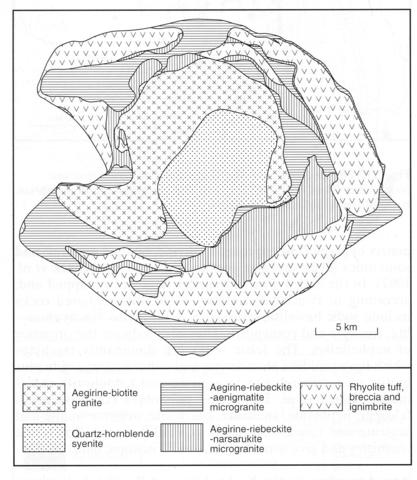stripes
The Mounio complex extends over 80 km north from the border with Nigeria and is probably continuous with the Matsena occurrence of that country (Nigeria, No. 122-00-02). The northern part of Mounio comprises a distinct ring-complex which is known as Goure. The central and southern parts of the Mounio complex are surrounded, and partly obscured, by a sea of sand, only in two areas are contacts with mica schists and quartzites exposed. More than 50% of the complex is occupied by rhyolite, rhyolitic breccia and tuffs and the rest dominated by amphibole-aegirine and arfvedsonite-aegirine-aenigmatite granite and aegirine-amphibole-aenigmatite microgranite (Bessoles and Trompette, 1980). The Goure ring structure has a diameter of 30 km. Initial igneous activity involved extrusion and intrusion of rhyolites, including comendite, and rhyolitic tuffs, breccias and ignimbrites. These rocks have been preserved by the subsidence of arcuate blocks around the border of the complex. They have a constant mineralogy with aegirine and sodic amphibole invariably present. An intrusive cycle commenced with microgranites of aegirine-riebeckite-narsarsukite and aegirine-riebeckite-aenigmatite which occupy a broad outer zone. In the former rock the pyroxene and amphibole commonly form spongy, poikilitic crystals, while in the latter the pyroxene grades into aegirine-augite and often fringes the amphibole; both the riebeckite and aenigmatite may be poikilitic. The core of the complex is formed of a quartz-hornblende syenite, in which the hornblende may be rimmed by riebeckite, and intrusion of which was followed by an aegirine-biotite granite along the contact of the syenite and outer microgranites. Analyses of Goure rocks will be found in Black (1963).
BESSOLES, B. and TROMPETTE, R. 1980. Geologie de l'Afrique. La chaine panafricaine “zone mobile d’Afrique centrale (parie sud) et zone mobile soudanaise”. Mémoire du Bureau de Recherches Géologiques et Minières, 92: 1-397.BLACK, R. 1963. Notes sur les complexes annulaires de Tchouni-Zarniski et de Gouré (Niger). Bulletin, Bureau de Recherche Géologie et Minière, 1: 31-45.BOWDEN, P., VAN BREEMEN, O., HUTCHINSON, J. and TURNER, D.C. 1976. Palaeozoic and Mesozoic age trends for some ring complexes in Niger and Nigeria. Nature, London, 259: 297-9.

